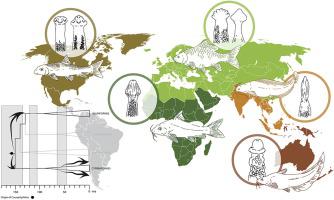International Journal for Parasitology ( IF 3.7 ) Pub Date : 2020-12-02 , DOI: 10.1016/j.ijpara.2020.09.009 Tomáš Scholz 1 , Andrea Waeschenbach 2 , Mikuláš Oros 3 , Jan Brabec 1 , D Timothy J Littlewood 2

|
Tapeworms of the order Caryophyllidea are the earliest diverging ‘true’ tapeworms (Eucestoda) and parasitise cypriniform and siluriform fishes almost exclusively. They are typified by a monozoic (non-proglottised) body plan, which is a characteristic shared with early diverging ‘cestodarians’ Gyrocotylidea and Amphilinidea. Here we present the most comprehensive multi-gene molecular phylogeny of this group, to date. Specimens of 63 species from 32 genera (~50% and ~75% of known species and genus diversity, respectively) were gathered during an intense and targeted 15-year collecting effort. Phylogenetic reconstructions provide high nodal support for three major lineages, which only partly correspond to currently recognised families. The three well-supported clades were as follows: Clade A was in an unsupported position at the base of the tree and was almost exclusively comprised of parasites of catfishes (Siluriformes) from the Afrotropical and Indomalayan regions, including the type genus of the Lytocestidae (Lytocestus). Clade B formed the sister group to the remaining taxa (Clade C) and was composed of species that parasitise cyprinids and loaches (Cypriniformes: Cyprinoidei and Cobitoidei) from the Palaearctic Region. This clade included the type genus of the Caryophyllaeidae (Caryophyllaeus). Clade C comprised Nearctic species from suckers and minnows (Cypriniformes: Catostomidae and Cyprinoidei), which were previously accommodated in two families, i.e. Capingentidae and Caryophyllaeidae. This clade included the type genus of the Capingentidae (Capingens). In addition to Clades A–C, Balanotaenia bancrofti from the monotypic Balanotaeniidae, which parasitises plotosid catfishes in Australia, and Lytocestoides tanganyikae, which parasitises African cichlids, formed a poorly supported clade at the base of the tree. Whereas morphological characteristics traditionally used to differentiate caryophyllidean families do not characterise molecular lineages, host association and biogeographical distribution play a key role in the circumscription of the three well-supported clades revealed by molecular data. Thus, the taxonomic rearrangement proposed herein was guided by the molecular clades. The names of all four extant families were preserved and family affinity was determined by topological clustering with the type genera of the families. The family diagnoses of the Lytocestidae, Caryophyllaeidae and Capingentidae are amended. Biogeographic patterns are indicative of separate Gondwanan and Laurasian radiations having taken place. Regarding the Gondwanan radiation in the Siluriformes, the topology in Clade A indicates an Asian origin with a subsequent African colonisation. Concerning Laurasia, separate radiations appear to have taken place in the Cypriniformes in the temperate zones of North America and Eurasia. Complete absence of caryophyllideans in the Neotropical Region, where numerous catfishes occur, may be due to the Gondwanan radiation having taken place after the continental separation of Africa and South America.
中文翻译:

早期发散绦虫(Cestoda:Caryophyllidea)的系统发育重建揭示了脊椎动物宿主和生物地理区域的远古辐射
Caryophyllidea 目绦虫是最早发散的“真”绦虫(Eucestoda),几乎完全寄生于鲤形和鲶形鱼。它们的典型特征是单生(非节节)体型,这是早期分化的“绦虫” Gyrocotylidea 和 Amphilinidea 的共同特征。在这里,我们展示了迄今为止该组最全面的多基因分子系统发育。在为期 15 年的密集和有针对性的收集工作中,收集了来自 32 个属的 63 个物种的标本(分别占已知物种和属多样性的约 50% 和约 75%)。系统发育重建为三个主要谱系提供了高节点支持,这些谱系仅部分对应于当前公认的家族。三个得到良好支持的进化枝如下:莱托斯特斯)。进化枝 B 与其余分类群(进化枝 C)形成姐妹群,由寄生于古北区的鲤科动物和泥鳅(鲤形目:鲤科动物和鳅鱼)的物种组成。这个进化枝包括石竹科 ( Caryophyllaeus )的类型属。进化枝 C 包括来自吸盘和小鱼(鲤形目:Catostomidae 和 Cyprinoidei)的 Nearctic 物种,它们以前被分为两个科,即 Capingentidae 和 Caryophyllaeidae。这个进化枝包括 Capingentidae ( Capingens )的类型属。除了 Clades A–C、来自单型 Balanotaeniidae 的Balanotaenia bancrofti之外,它寄生于澳大利亚的斑点鲶鱼,以及Lytocestoides tanganyikae寄生于非洲慈鲷的 ,在树的底部形成了一个支撑不良的进化枝。传统上用于区分石竹目科的形态特征并不表征分子谱系,而宿主关联和生物地理分布在分子数据揭示的三个得到充分支持的进化枝的界限中起着关键作用。因此,本文提出的分类重排是由分子进化枝引导的。保留了所有四个现存科的名称,并通过与科的类型属进行拓扑聚类来确定科的亲缘关系。修正了石螟科、石竹科和刺螟科的科诊断。生物地理模式表明发生了单独的冈瓦纳和劳亚斯辐射。关于 Siluriformes 中的冈瓦纳辐射,进化枝 A 中的拓扑结构表明亚洲起源和随后的非洲殖民。关于劳亚大陆,北美洲和欧亚大陆温带的鲤形目似乎发生了不同的辐射。在出现大量鲶鱼的新热带地区完全没有石竹鱼,这可能是由于非洲和南美洲大陆分离后发生的冈瓦纳辐射。









































 京公网安备 11010802027423号
京公网安备 11010802027423号